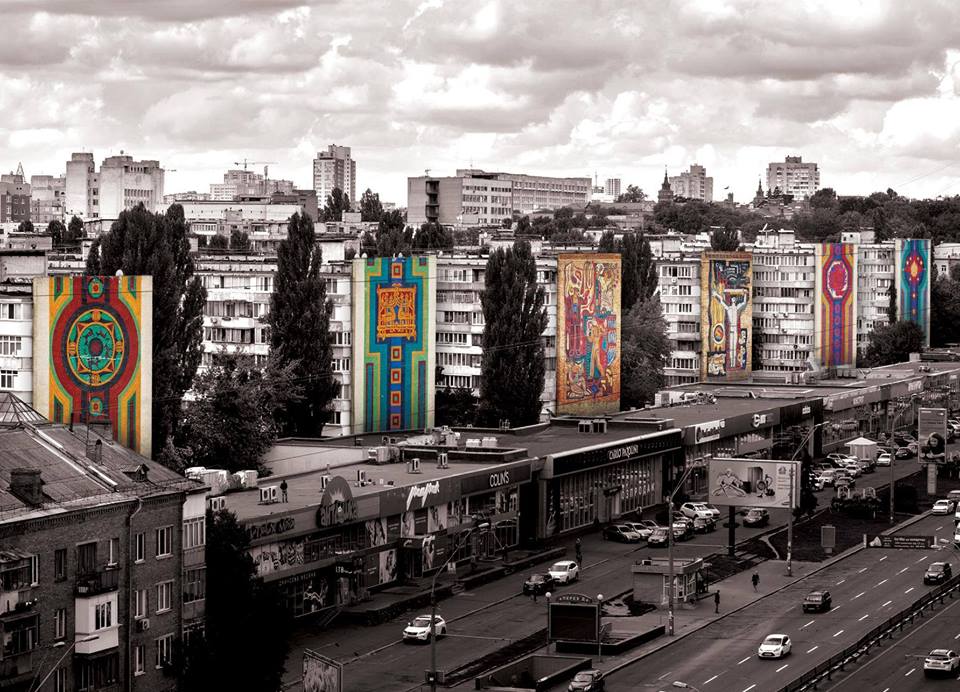Action and reaction, the art of politics and political art in Ukraine. Part three
40 years ago artist Volodymyr Pryadka completed work on a monumental series of mosaics on 6 buildings in Kiev. The residential apartment blocks, side by side, proudly present this, their best side, to residents and commuters on one of the wide boulevards spanning out from the city centre. The mosaics, crafted by a team of artists are vibrant examples of contemporaneous design, depicting scenes of workers’ endeavor and motherhood. Artworks so well crafted they have withstood many a bitter winter with its unforgiving frost.
40 years to the day we are standing on the pavement on Peremohy Avenue, the evenings are turning chilly and we have mulled wine in paper cups to keep us warm. In the setting sun, the colours of the mosaics still sing. Olga, who has lived across the road for many years tells me how lucky she is to open her curtains to see these mosaics every day. We are 50 or so people and Volodymyr, the only surviving artist is telling us his story. It is a story of pride, but it is also a story of sadness.
Behind him, 4 young artists are quietly digging a hole, placing a sign, and filling the hole with concrete. The sign on the grassy verge separating us from the six-lane trunk road, tells us about the mosaic across the road. The kind of sign, with a QR code, that we might see in any European city explaining the artwork in front of us.
But today, here in Kiev, this signage is a work of activism and the brainchild of artist Zhenya Molyar and Kiev based producers, CSM.
The mosaics, like other works of art in Kiev, have fallen foul of a new law. A law passed by President Poroshenko in April 2015 making recognition of the 1917-1991 Communist totalitarian regime in Ukraine a ‘criminal’ activity and outlawing Communist symbols and propaganda.
In addition to the renaming of streets and entire towns, this new legislation has meant the removal of sculptures, mosaics and architectural detail. The Peremohy mosaics are just one small example of soviet era works of art and design that are at risk because they contain symbols of Ukraine’s history.
These new laws have been widely questioned both nationally and internationally with claims that they contradict fundamental human rights including freedom of expression and assembly. There are calls for amendments to the law.
Meanwhile Zhenya along with other artists across the country are making their voices heard.
In 2015 Clymene took part in the British Council Canny Creative Fellowship in Kyiv, Ukraine. The fellowship placed her with the Congress of Cultural Activists and CSM, Contemporary Arts Institute. These blogs reflect her brief time embedded in the culture and politics of Ukraine.
40 years ago artist Volodymyr Pryadka completed work on a monumental series of mosaics on 6 buildings in Kiev. The residential apartment blocks, side by side, proudly present this, their best side, to residents and commuters on one of the wide boulevards spanning out from the city centre. The mosaics, crafted by a team of artists are vibrant examples of contemporaneous design, depicting scenes of workers’ endeavor and motherhood. Artworks so well crafted they have withstood many a bitter winter with its unforgiving frost.
40 years to the day we are standing on the pavement on Peremohy Avenue, the evenings are turning chilly and we have mulled wine in paper cups to keep us warm. In the setting sun, the colours of the mosaics still sing. Olga, who has lived across the road for many years tells me how lucky she is to open her curtains to see these mosaics every day. We are 50 or so people and Volodymyr, the only surviving artist is telling us his story. It is a story of pride, but it is also a story of sadness.
Behind him, 4 young artists are quietly digging a hole, placing a sign, and filling the hole with concrete. The sign on the grassy verge separating us from the six-lane trunk road, tells us about the mosaic across the road. The kind of sign, with a QR code, that we might see in any European city explaining the artwork in front of us.
But today, here in Kiev, this signage is a work of activism and the brainchild of artist Zhenya Molyar and Kiev based producers, CSM.
The mosaics, like other works of art in Kiev, have fallen foul of a new law. A law passed by President Poroshenko in April 2015 making recognition of the 1917-1991 Communist totalitarian regime in Ukraine a ‘criminal’ activity and outlawing Communist symbols and propaganda.
In addition to the renaming of streets and entire towns, this new legislation has meant the removal of sculptures, mosaics and architectural detail. The Peremohy mosaics are just one small example of soviet era works of art and design that are at risk because they contain symbols of Ukraine’s history.
These new laws have been widely questioned both nationally and internationally with claims that they contradict fundamental human rights including freedom of expression and assembly. There are calls for amendments to the law.
Meanwhile Zhenya along with other artists across the country are making their voices heard.
In 2015 Clymene took part in the British Council Canny Creative Fellowship in Kyiv, Ukraine. The fellowship placed her with the Congress of Cultural Activists and CSM, Contemporary Arts Institute. These blogs reflect her brief time embedded in the culture and politics of Ukraine.


 RSS Feed
RSS Feed